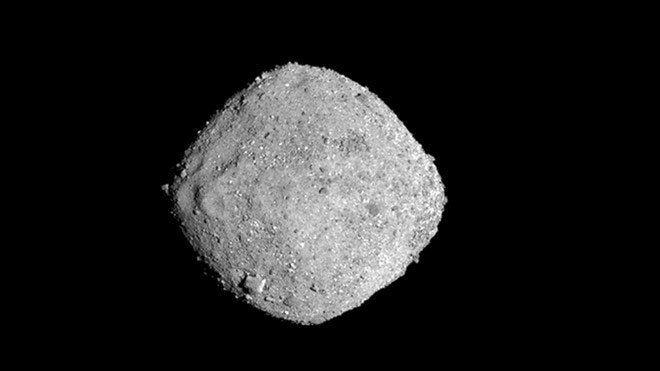NASA spacecraft approached the meteorite that could collide with the Earth
After a two-year journey of two billion kilometers, NASA's Osiris-Rex spacecraft successfully approached and became the first "guest" to visit the meteorite Bennu for billions of years.
On December 3, the Osiris-Rex probe was only 19 km away from the Bennu meteorite and could even get closer in the coming days, before entering orbit around meteorite on December 31. Until now, there has never been a ship in the world that has flown around such a small celestial body.
Bennu meteorite is estimated to have a diameter of 500m. Scientists will publish more accurate descriptions of this object at a scientific conference on December 10 in Washington.
According to AP, this is the first US effort to collect specimens from meteorites and bring back to Earth, an achievement that only Japan has so far achieved.

The image of Bennu meteorite was captured by NASA on November 16.(Photo: NASA).
Osiris-Rex's group of cruise control scientists cheered and slapped each other as soon as they confirmed that the ship was able to reach Bennu. This good news follows the fact that another NASA spacecraft successfully landed on Mars last week.
'Relieved, proud and restless wanting to start exploring!' , Dante Lauretta, University of Arizona lead scientist posted on Twitter. 'Go to Bennu and come back!'
At a distance of 122 million kilometers, 7 minutes is the time required for information from the airship to the control station at Lockheed Martin in Colorado, USA. This is also where Osiris-Rex was built.
The $ 800 million spacecraft was launched from Cape Canaveral, Florida, in 2016. On December 3, the data on the next journey was 2 billion km. As big as an SUV, the spacecraft will follow the meteorite Bennu for a year, before collecting dust samples and returning to Earth at 2023.
Scientists are eager to study specimens from carbon-rich meteorites like Bennu. According to them, this meteorite can hold evidence dating back to 4.5 billion years, since the Solar System began to form. In other words, Bennu is like the time capsule of astronomical history.

Illustration Osiris-Rex spacecraft.(Photo: NASA).
The mission of Osiris-Rex is to collect at least 60g of rock dust. Instead of landing directly, the spacecraft will use a 3m long arm to reach the meteorite surface by 2020. The sample container will then separate from the spacecraft and start heading towards Earth by 2021.
This may be the biggest 'harvest' from the universe since Apollo astronauts brought the moon to Earth in the 1960s and 1970s. Previously, NASA had collected material particles from the solar wind and meteor dust, but had never obtained samples from meteorites.
In the meantime, Japan brought back dust samples from the Hayabusa meteorite in the first mission in 2010. It is also "hunting" another meteorite near Earth from June to collect specimens. . This meteorite is named Ryugu, twice as big as Bennu. The dust from Ryugu will be brought to Earth in December 2020.
Both Bennu and Ryugu are evaluated as potentially dangerous meteorites because they can collide with the Earth. Bennu is expected to hit Earth within 150 years.
Lauretta stressed that the spacecraft approaching Bennu would not cause any significant changes to the meteor's orbit and would not make it more dangerous to humans. The researchers claim that the more they know about meteorites, the better the Earth will be able to be prepared before the catastrophic forecast for the future.
- Giant meteorite approached the Earth at midnight on September 7
- Double meteorite fly near Earth
- NASA launched a meteorite research satellite that could destroy the Earth
- The 50m meteorite may crash into Earth later this year
- 5 NASA steps dealing with meteorites crash into Earth
- Next month, a meteorite approached the earth
- NASA's Maven spacecraft approached Mars
- A mountain-like meteorite can hit the earth
- Large meteorite by bus has just approached the Earth
- NASA discovered 72 asteroids that could collide with the Earth
- NASA discovered a large meteorite heading towards Earth
- The 2004 meteorite XP14 skimmed near Earth
 Van Allen's belt and evidence that the Apollo 11 mission to the Moon was myth
Van Allen's belt and evidence that the Apollo 11 mission to the Moon was myth The levels of civilization in the universe (Kardashev scale)
The levels of civilization in the universe (Kardashev scale) Today Mars, the sun and the Earth are aligned
Today Mars, the sun and the Earth are aligned The Amazon owner announced a secret plan to build a space base for thousands of people
The Amazon owner announced a secret plan to build a space base for thousands of people